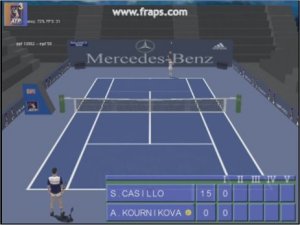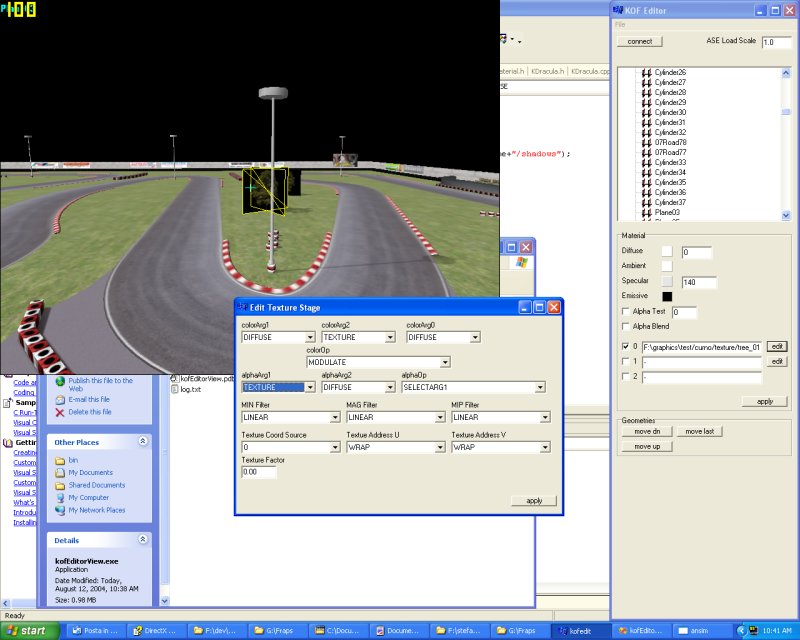
Hi there,
Another week of hard work is gone since my last update. Focus here is still 100% on graphics improvements. The brand new 3D engine is almost finished in its features. In particular, the multitexture FFP (Fixed Function Pipeline) half of it is basically terminated. I am now concentrating on the programmable shader part, and I've got to tell you: it is an exciting revelation! I'll be back on the shader thing in a while.
DRACULA EVOLUTION
The biggest change in the 3D engine is in its "lower" level of abstraction
and closer resemblance to DirectX organization. Dracula, the code name I gave
to this 3D engine 4 years ago started its life as an OpenGL 3D class library.
I begun coding Dracula while I was still in Italy waiting for my transfer to
the UK. It was a major rewrite of another 3D I've been using for years. The
main feature of Dracula was support for animations. At that time, I was planning
to create an engine capable of handling a RPG similar to Ultima X and based
in Japan. Character animation was my first priority then. I kept working to
Dracula for some months in Italy, then, once in UK, I refined it and started
using it in an open source tennis simulator called ATP3 (atp3.sourceforge.net).
Here's a funny video of ATP3 in which I am kicking Anna Kournikova's ass. (I
wish ;-) )
ATP3 hmm.. why that "3" you could ask. Well it was actually my 3rd
go at a tennis game. The first 2 were 2D with amazing ( :-D it really was) AI
that even made AI vs AI matches interesting to watch. ATP3 was to take the same
approach and translate it into a full 3D scenario.
As you might imagine ATP3 was never finished because I started being sucked
into netKar development. For netKar, I begun using the very same Dracula engine
used for ATP3. 2 or 3 months before netKar's first public release I decided
to move the entire engine to DirectX. The decision at that time was, ironically,
justified by what I am doing now: supporting advanced shading. The movement
was a real pain, OpenGL version of Dracula was based on the idea of "display
lists", a very easy way to obtain very quick static geometry rendering
in OpenGL. Display Lists are heavily dependent on the video card's OpenGL driver.
nVidia always had a fantastic driver and to match display list's performance
using DirectX was a real challenge. DirectX asks much more to the developer,
and Dracula was filled with "hacks" everywhere to hide DirectX complexity
behind a class structure I was familiar with.
Now, for the first time in 4 year I've accepted the idea of redesigning the
engine's part that neeed more attention to strictly match DirectX's structure.
It took a lot of code to be rewritten and re-thought, but I think the advantages
will be evident pretty soon, when Outrunner will be able to use all the parameters
accesible by the editor.
As you can see from this screenshot:

The window called "Edit Texture Stage" is used to set all those parameters
for single texture pass. They're mapping 1:1 the equivalent DirectX calls. Old
nK's 3D engine had to "guess" those parameters from the context, not
an easy task and not a very flexible approach. Now I will only have to sit down
and wait to see what Outrunner will be able to come up with using this editor.
SHADOWS
For static shadow I fell back to the standard "Quake" approach, that
is: lightmaps. They look better than anything else, "only" require
an additional texture pass with the disadvantage of eating up some video memory.
But we're doing it properly, and, of course, the user will be able to switch
the shadows off if not needed.
Doom3 just came out and users will be expecting to see realistic shadows everywhere
now. For a racing game, Doom's approach to shadows just won't work. Tracks have
a big part of their content based on alpha tested texture, as for trees, poles
and so on. Doom's shadows won't support alpha testing and they need a close
silouette to cast shadow from.
I am starting some experiment with directional shadow mapping, that is a slightly
different beast from Doom's shadow, much easier to understand and they have
the big advantage of being fully real time. The catch me is that they are a
bit tricky to implement for large areas like racing tracks. I think I will stick
with lightmaps for nKpro V1.0 and implement this solution in the following versions.
SHADERS
This is a serious revolution. It is difficult to understand the potential of
these new generation video cards until you actually play and experiment with
it. The differences are also slightly less evident than a difference between
a good 3D model and a crap 3D model. That is to say, shaders won't save a bad
3D model, but will only make a great 3D model look better. What difference am
I talking here? Well, I've prepared a nice present for you today:
In this video:
You can see a comparison between the "standard" lighting function
in DirectX and a shader for per-pixel lighting. In the middle of the video I
will switch to per-pixel shader for the car's body. Judge yourself the difference:
the specular part (the bright highlight on the car paint) in the shader version
is amazing, the car's curved surface appears incredibily soft and it is much
easier to understand the shape of the body. I think this example is more explicit
than a million words, and this is JUST one of the most basic shaders to experiment
with, there are possibility to generate things like fabrics, grass, velvet and,
of course, bump mapped road surfaces and better environment mapping.
I really look forward to 3D graphics in the next couple of years when we will
be able to move into a full 3D "shaders" world with the new 3D cards
on the market.
ciao for now.. see you next week!
stefano